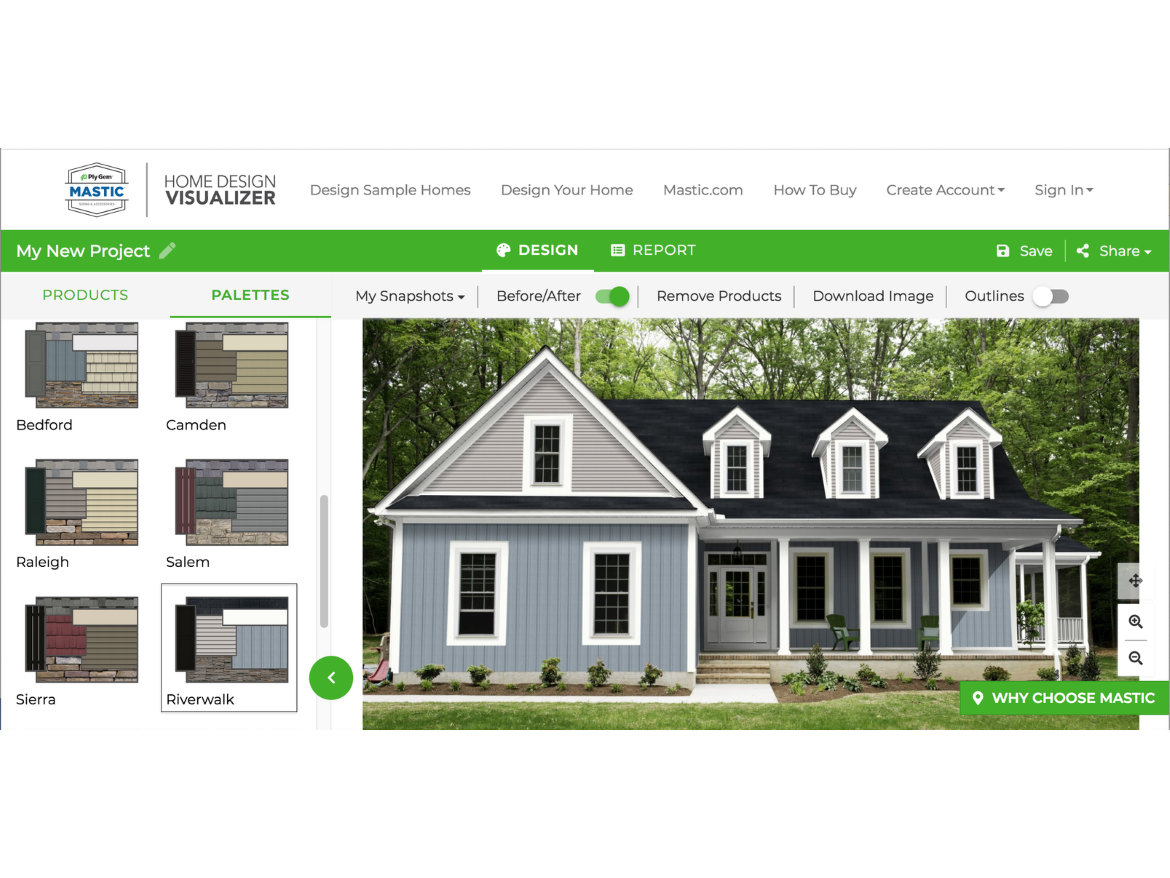Tips for Contractors When Working With Homeowners on Design
You don’t have to be a design expert to make sure your customers get the look they’ve been dreaming of. Just follow these three tips.

Trends in exterior design often inspire new product developments, and vice versa. This home features Solar Defense technology by Ply Gem, which uses light-reflecting properties and heat-resistant base layers to provide darker, fade-resistant colors.

Sharing before and after images, whether from your own portfolio or from an online visualizer tool, is a great way to connect with homeowners early in the design process.

Online visualizers are an excellent tool for helping homeowners identify and communicate their vision for their exterior remodel. The Ply Gem Home Design Visualizer features multiple pre-selected palettes to inspire homeowners.



Translating what homeowners picture in their minds into what they see on their property can be a challenging task. As a contractor, your area of expertise is recommending the right product based on performance, ease of install, and availability – while the homeowner may be selecting a product based on criteria that are harder to express: issues of design, perceptions of quality, or simply what feels like “home.” In spite of any short-term communication challenges, the reality is your long-term goals are perfectly aligned. The homeowner expects a beautifully remodeled exterior as a result of your work – and your goal is a profitable project with a satisfied customer.
We’ve tapped into industry experts to get their tips on how to understand your homeowners’ exterior design expectations. Leverage these three best practices to deliver a streamlined experience, delight customers, and improve your bottom line.
Create Open Dialogue and Meet the Homeowner Where They Are
The starting point for homeowners beginning a remodel can be all over the map.
The durability of exterior siding, trim, and accents means that for many homeowners, an exterior remodel is a once-in-a-lifetime project. On the other hand, there are a lot of resources available to them, so it’s difficult to know just how much they have thought about design. They may have been watching home improvement shows or researching online and know exactly the look they want, or they may simply know they want it to look fantastic.
It’s important to not make assumptions about the information the homeowner has gathered. The key to determining what stage of exploration they are in is through clear communication. Asking the customer direct questions such as, “Do you have any images for inspiration?” and “What specifically about these images do you like?” can help to determine common threads and narrow down what your customer is seeking.
“Some have done research, and some are starting with a blank slate,” said David Johnston, Director Product Marketing, Ply Gem Residential Solutions. “Some have created Pinterest boards filled with examples from home renovation shows, others have driven through neighborhoods.”
Having a clear discussion and asking specific questions allows you to narrow down the options to better advise your customer.
Go Beyond the Fan Deck
When spending thousands of dollars on an exterior remodeling project, homeowners expect to instantly see what they’re getting before they purchase. Fortunately, technology has made that possible. Gone are the days of using small swatches of siding or pictures of other people’s homes to make color decisions. Using an online visualizer is a quick, effective way to be sure the customer truly knows what their choices will look like on their home.
In addition to creating renderings, online visualizers can help simplify complicated color selection for homeowners and help them make a design decision so you can order products and schedule them for installation faster. For example, they might know that they want a gray and white house, but do they want a gray with blue undertones, brown undertones, or green undertones? A visualizer can help the homeowner dial in the color selection process, while you focus on your areas of expertise, like installation schedule and prospecting other customers.
Visualizers also create a space for homeowners to explore new ideas. “Shutters, as well as features like shake and shingle or stone accents, can do so much to enhance the look of a home. When a homeowner can see accents like this on their own home and receive instant gratification, the results can be excellent,” said Ply Gem home exterior design consultant, Susan McKenzie. Exploring new color and material combinations can lead to a more profitable project, as well as happier customers.
“There’s an old saying that ‘good design is good business’. The same is true for visualizers. They can make great prospecting and closing tools,” notes Johnston. “Even as part of the scouting experience, contractors can snap a photo of a home prior to an initial meeting, bringing ideas along to the first encounter with a homeowner. The promise of professional renderings can also create a compelling reason to retain the ‘design-focused’ contractor over ‘installation-focused’ contractors who don’t offer a design experience.”
Explore the Intersection of Trends and High-performance Products
Understanding the relationship between remodeling trends and product innovations can help lead to long-term customer satisfaction and profitability. “Providing on-trend solutions with high performance can help give contractors a competitive edge in their market and increase their bottom-line,” says Johnston.
For example, in the early 2000’s color trends tended to be neutral beige and sand tones. “Now, we are seeing a migration to cooler tones, beginning with grey and evolving to the requests for blues and greens we see today,” explained McKenzie. As Millennials and ultimately Gen Z enter the market, colors choices are expected to become even bolder and more varied. Because of this, vinyl siding manufacturers have risen to the occasion and evolved material technologies to provide darker colors that resist fading.
Another trend that has grown in the last several years has been the use of mixed materials. “There’s been an increased interest and willingness to try other textures besides traditional vinyl lap siding,” noted Johnston. The use of shake and shingle on gabled areas, or perhaps the incorporation of stone on foundation or columns, is something that is occurring more often. Most homeowners lack the time and design skill to search through thousands of color and material combinations to achieve the desired look for their home. If you as the contractor understand the relationship between current trends and products innovations and use the tools provided by manufacturers, suggesting the perfect fit for a client will be easier than ever.
Homeowners may be anxious about committing to a material or color selection, but following these tips can help ensure a better overall experience for your customers, leaving them pleased with the end result - and happy to tell their friends and neighbors.
Looking for a reprint of this article?
From high-res PDFs to custom plaques, order your copy today!












